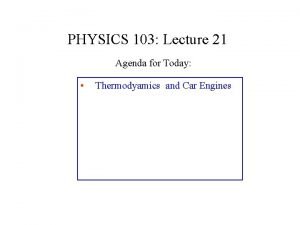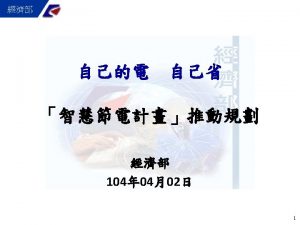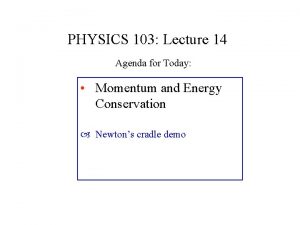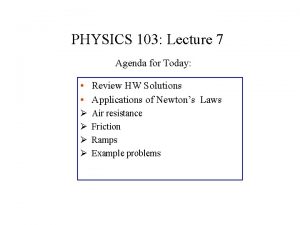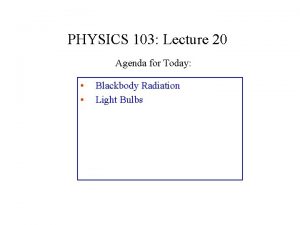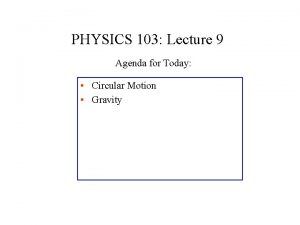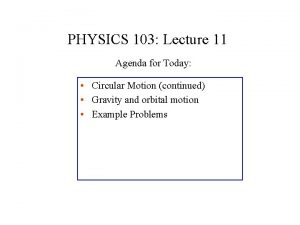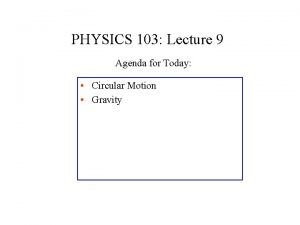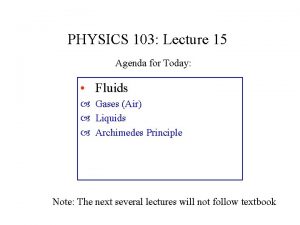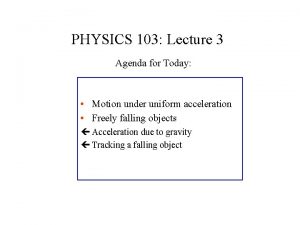PHYSICS 103 Lecture 21 Agenda for Today Thermodyamics














- Slides: 14

PHYSICS 103: Lecture 21 Agenda for Today: • Thermodyamics and Car Engines

LAWS OF THERMODYNAMICS: ZEROTH LAW Heat flows from hot objects to cold objects until they have the same temperature.

LAWS OF THERMODYNAMICS: FIRST LAW Conservation of Energy: All energy entering a system must be conserved HEAT: Q Change in internal energy I N DU OUT WORK: W = F d F Q = DU + W d

LAWS OF THERMODYNAMICS: FIRST LAW Example: D Internal Energy & Work Performed Example: D Internal Energy & No Work Performed HEAT: Q I N DU: KE T OUT WORK: W Q = DU + W

REAL ENGINES Internal Combustion Engine: 4 -stroke Otto cycle Step 1: Intake of gas-air mixture from the carburetor • Engine pulls piston out of cylinder • Low pressure in cylinder • Atmoshperic pressure pushes fuel air mixture into cylinder • Engine does work on gases during this stroke

LAWS OF THERMODYNAMICS: REAL ENGINES Internal Combustion Engine: 4 -stroke Otto cycle Step 2: Compression of the air-gas mixture • Engine pushes piston into cylinder • High pressure and temperature in cylinder • Engine does work on gases during this stroke

LAWS OF THERMODYNAMICS: REAL ENGINES Internal Combustion Engine: 4 -stroke Otto cycle Step 3: Ignition and Expansion of the air-gas mixture • Mixture burns to form hot gases • Gases push piston out of cylinder • As gas expands, pressure and temperature is lowered • Gas does work on engine during this stroke

LAWS OF THERMODYNAMICS: REAL ENGINES Internal Combustion Engine: 4 -stroke Otto cycle Step 4: Exhaust of waste gas • Engine pushes piston back into cylinder • Pressure inside pushes burnt gas out of cylinder • As gas expands, pressure and temperature is lowered • Engine does work on gas during this stroke

LAWS OF THERMODYNAMICS: REAL ENGINES Internal Combustion Engine: 4 -stroke Otto cycle

LAWS OF THERMODYNAMICS: REAL ENGINES Inline-4 Flat-4 V-6 Overhead Cam-4

ENGINE EFFICIENCY • Increase compression ratio => Get more work out of engine • Limit to compression ratio: knocking - spontaneous ignition of fuel/air mixture before the engine is ready to extract work • High compression ratio cars use premium gasoline. Higher octane ignites at higher temperatures • On most normal cars, premium gas is a waste of money

LAWS OF THERMODYNAMICS: Diesel ENGINES • Uses compression to ignite fuel - squeezes air to high pressure and temperature (compression ratio of ~ 20: 1 compared with 8: 1 - 12: 1) - injects fuel air in between compression and power strokes - fuel ignites spontaneously • High compression allows for high efficiency

Test Your Understanding • How does the burned gas do more work on the piston during the power stroke than the piston does on the unburned fuel-air mixture during the compression stroke? • Why is a car more likely to knock on a hot day than a cold day? • High compression ratio cars use premium gasoline. Higher octane ignites at higher temperatures • On most normal cars, premium gas is a waste of money

Main Points from Today’s Lecture • Engines You should understand that some of the heat (that flows from hot objects to cold objects) can be used to do work. Any device that does this is called a heat engine. You should have a basic understanding of the strokes of a car engine.
 Subaru flat 4
Subaru flat 4 01:640:244 lecture notes - lecture 15: plat, idah, farad
01:640:244 lecture notes - lecture 15: plat, idah, farad Agenda sistemica y agenda institucional
Agenda sistemica y agenda institucional Agenda for today
Agenda for today For todays meeting
For todays meeting Today's class work
Today's class work Proposal kickoff meeting agenda
Proposal kickoff meeting agenda Fingerprint ridge characteristics worksheet
Fingerprint ridge characteristics worksheet Today's lesson or today lesson
Today's lesson or today lesson Example of repitition
Example of repitition Classical mechanics
Classical mechanics Physics 101 lecture
Physics 101 lecture Physics 101 lecture 1
Physics 101 lecture 1 Physics 101 lecture notes pdf
Physics 101 lecture notes pdf Waves physics pdf notes
Waves physics pdf notes
